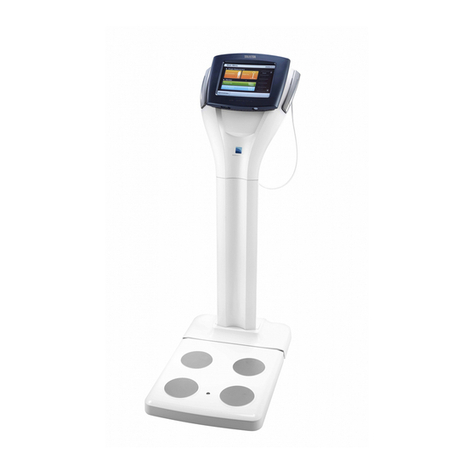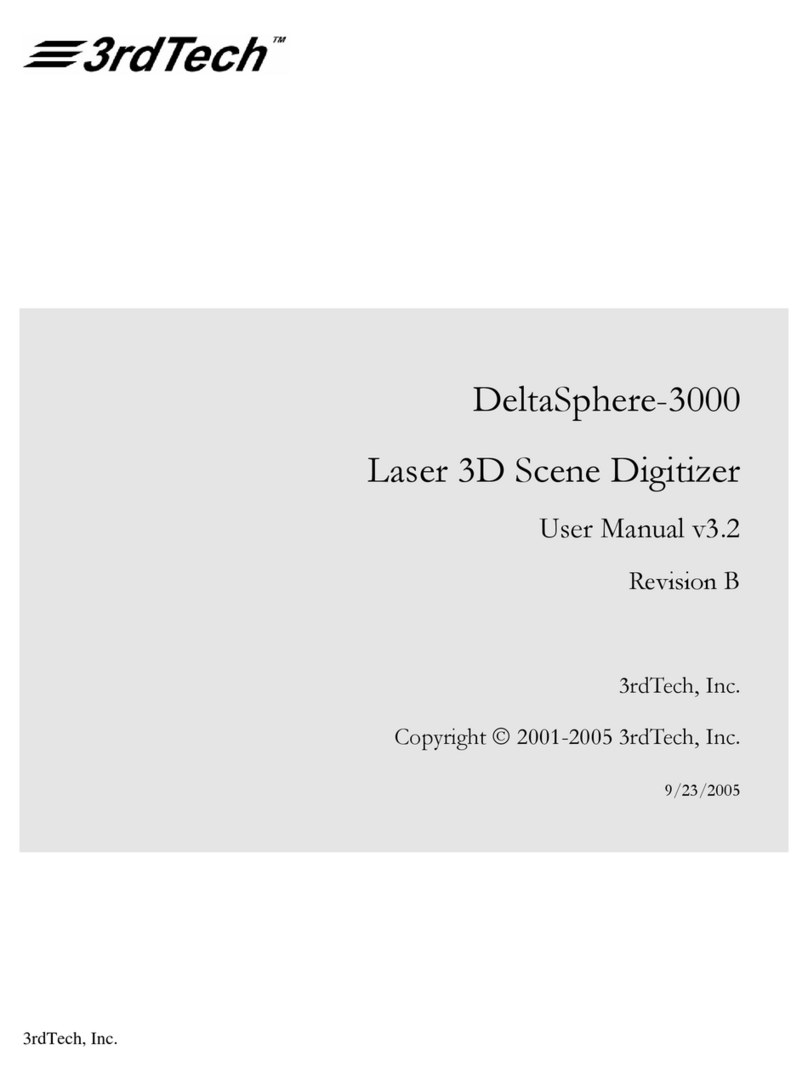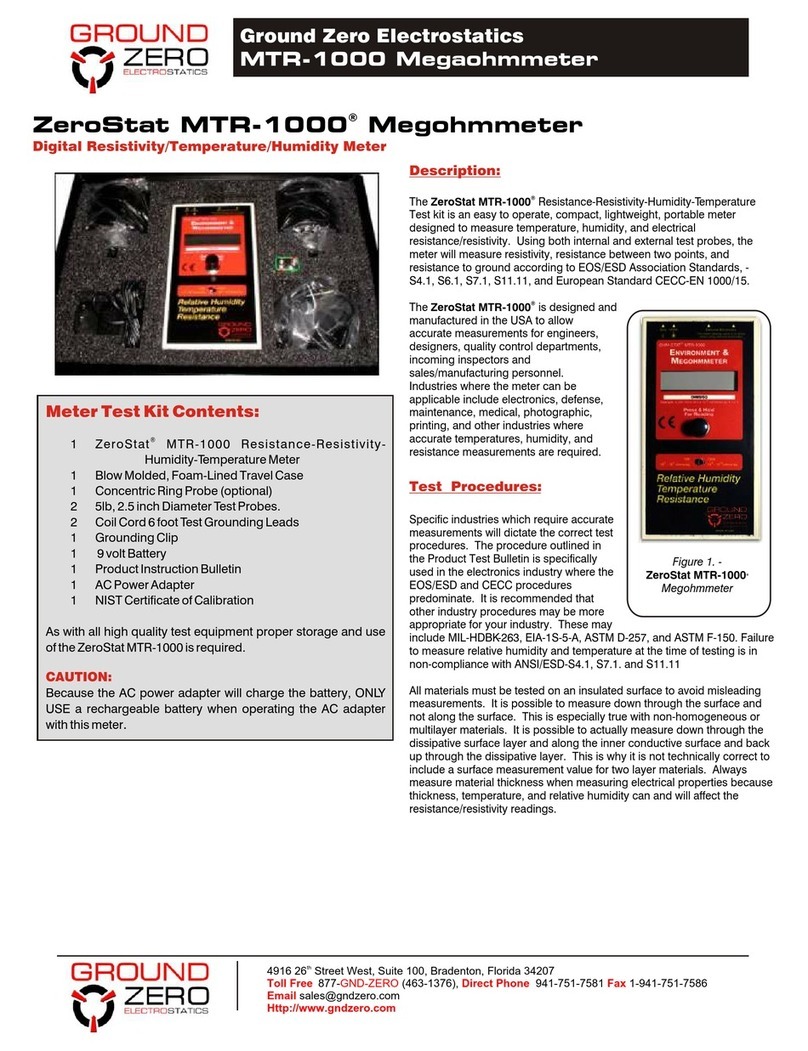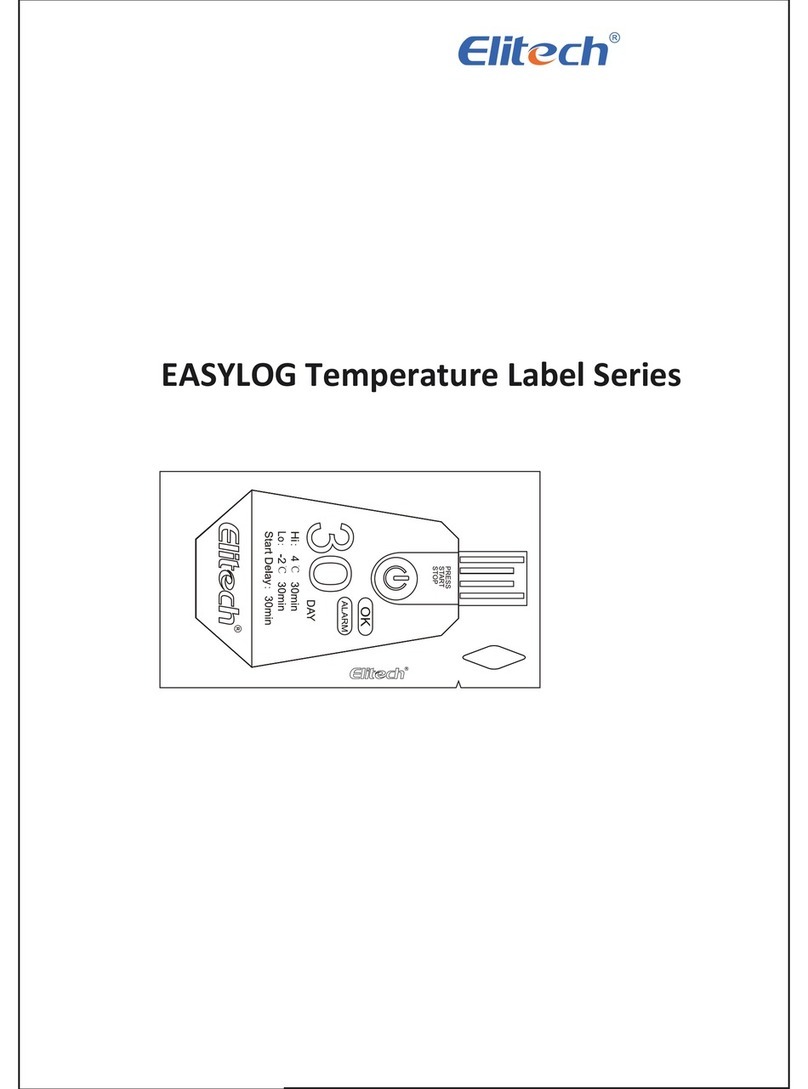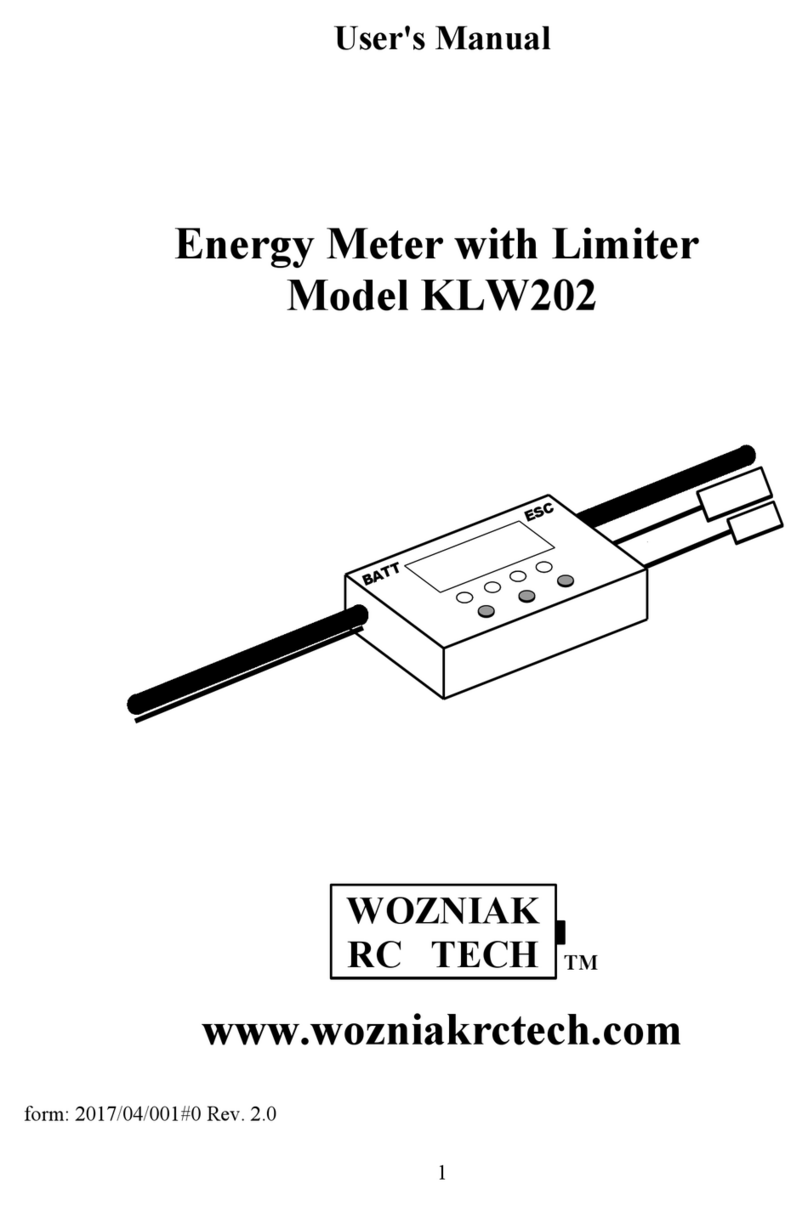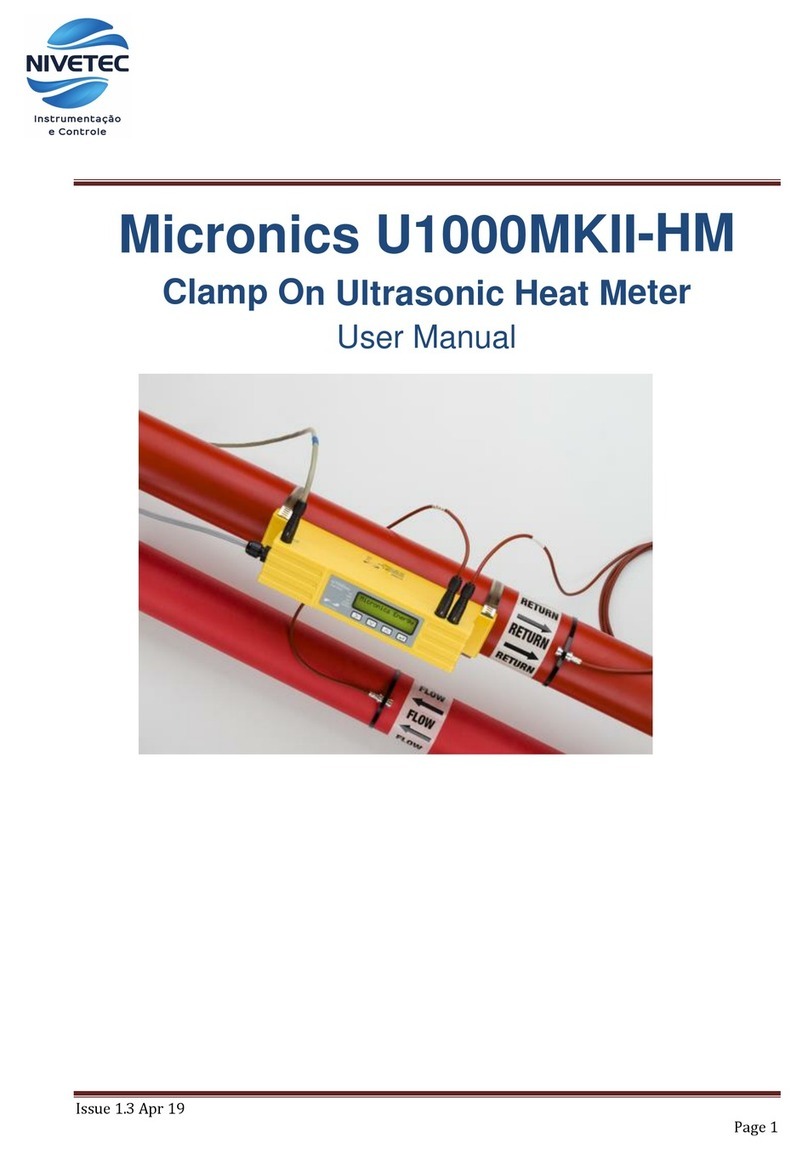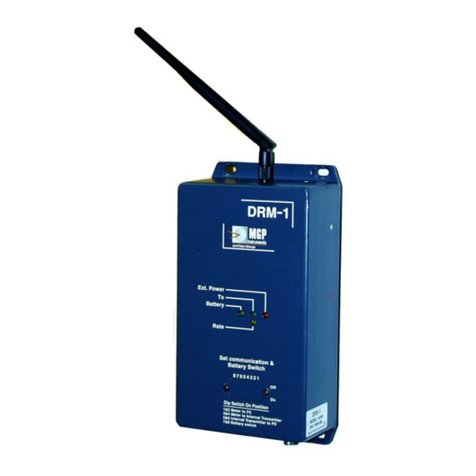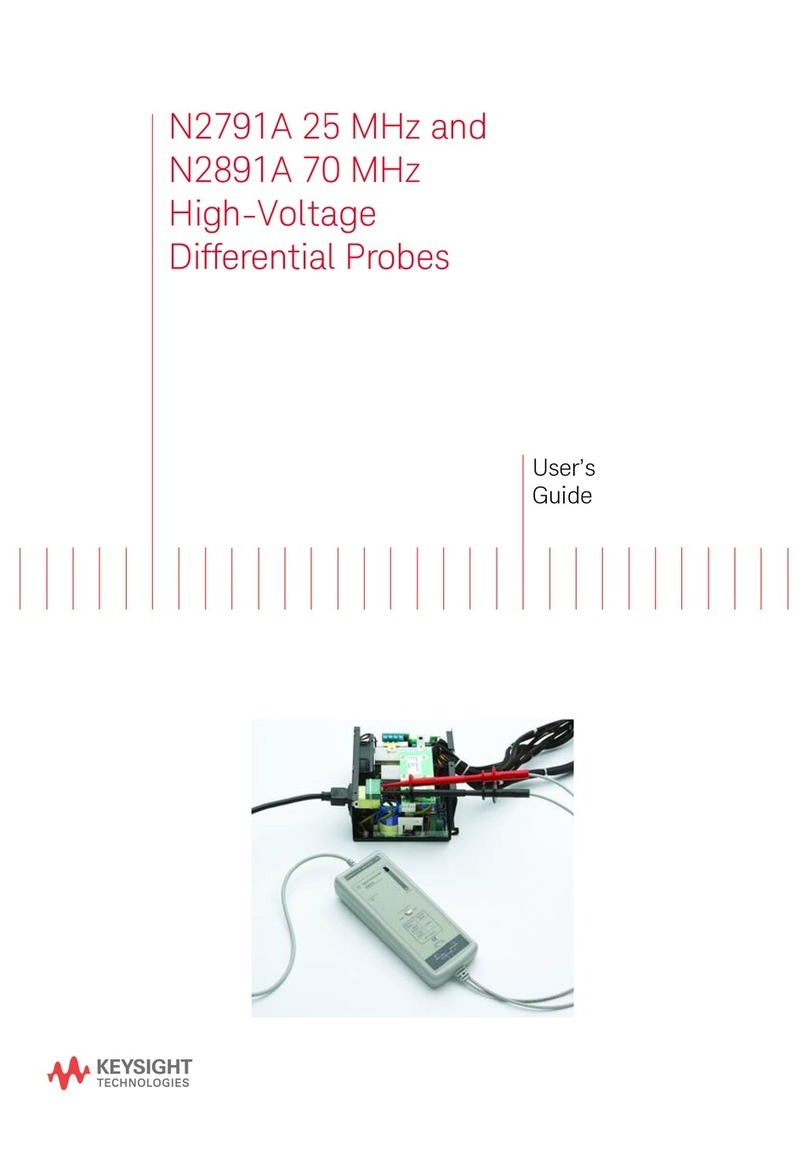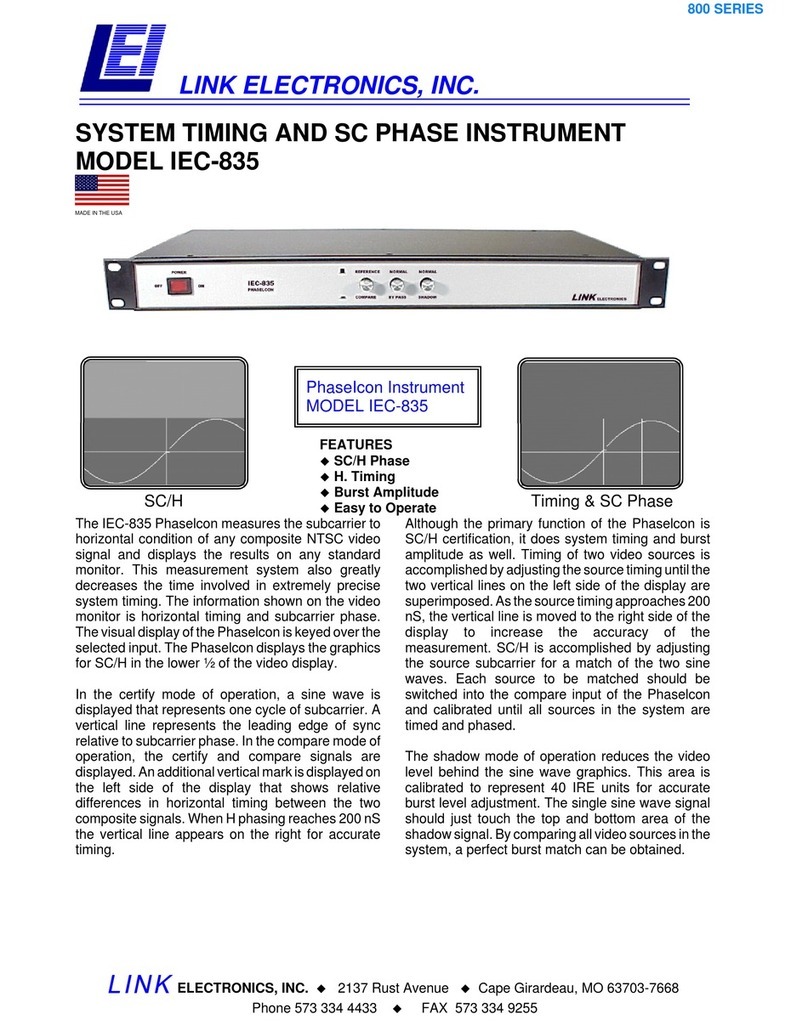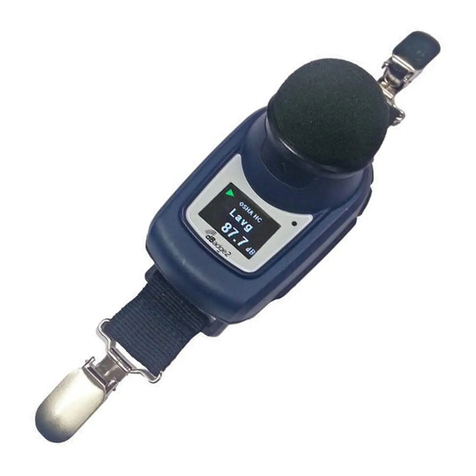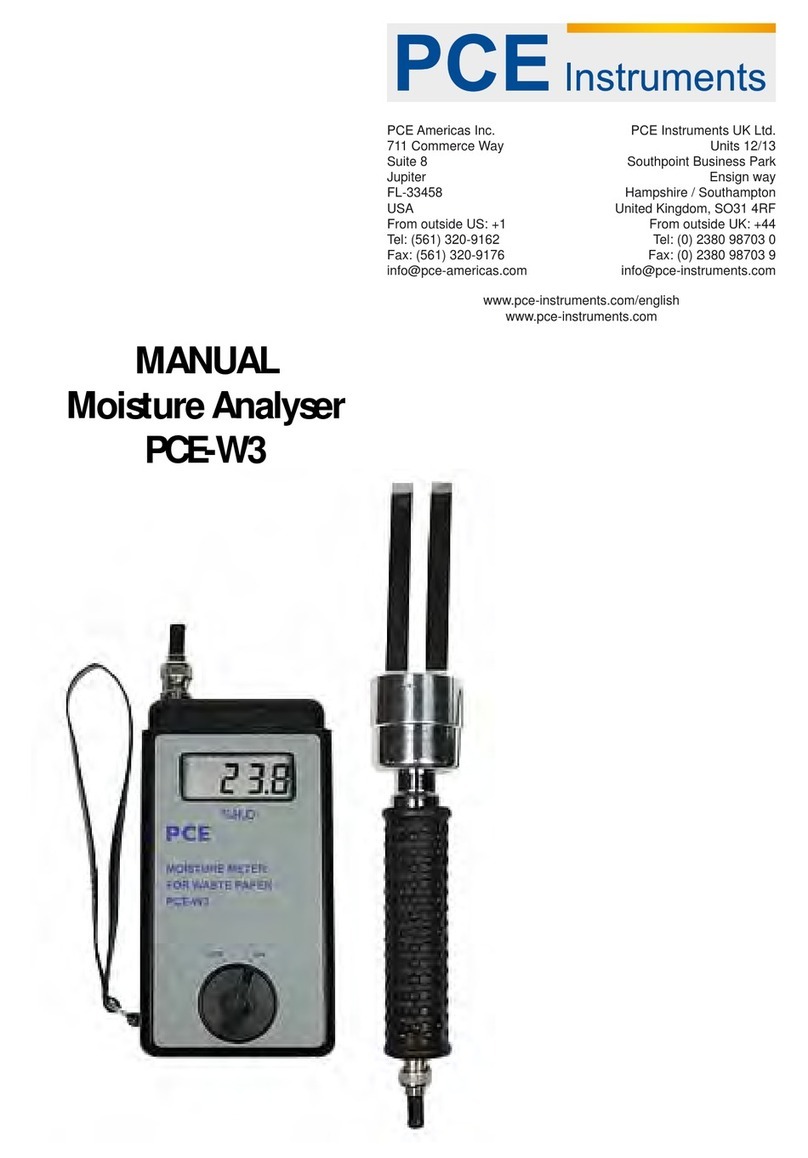Gigahertz-Optik P-9710 Series User manual

Page 1
Users Guide
P - 9710 series
Optometer
P - 9710 - 1, P - 9710 - 2, and P - 9710 - 4
Measurement and examination devices for optical radiation detectors
Version E 141203
Gigahertz-Optik GmbH
An der Kaelberweide 12,
D-82299 Tuerkenfeld.
Telephone +49 8193 93700 - 0
Telefax +49 8193 93700 - 50
info@gigahertz-optik.de
www.gigahertz-optik.de
Gigahertz-Optik Inc.
5 Perry Way
Newburyport MA 01950-4009 USA
Telephone:+ 978 462 1818
Telefax: + 978 462 3677
Email: b.angelo@gigahertz-optik.com
Website: www.gigahertz-optik.de

Page 2
Table of contents:
1. Additional information to the operating instructions
1.1 Safety precautions
1.2 Hazard clause
1.3 Liability
1.4 Safety
1.5 Environmental conditions
1.6 Maintenance and cleaning
1.7 Guarantee
1.8 CE Conformity declaration
1.9 Review clause
1.10 Contact details
2. Device description P - 9710 optometer
2.1 Intended use
2.2 Inspection
2.3 Technical specifications P - 9710 series
2.4 Additional technical specifications P - 9710
variants
2.4.1 Optometer P - 9710 - 1
2.4.2 Optometer P - 9710 - 2
2.4.3 Optometer P - 9710 - 4
2.5 Description of the measurement ranges
2.6 Device overview
2.7 Detector interface
2.8 RS232 Interface / Analog Output
2.9 Trigger input (device variant P - 9710 - 4 only)
3. Performing measurements
3.1 Version Info
3.2 Quick start guide
3.3 P - 9710 Menu Structure
3.3.1 General information
3.3.2 Menu Overview
3.3.3 Front panel buttons
3.3.4 Menu description “Mode”
3.3.5 Menu description “Range”
3.3.6 Menu description “Detector”
3.3.7 Menu description “Offset”
3.3.8 Menu description “Reference”
3.3.9 Menu description “Substitution”
3.3.10 Menu description “Setup”
3.3.11 Menu description “Info”
3.4 Remote Interface (RS232)
Page
4
4
4
5
5
5
6
6
6
6
7
8
8
8
9
10
10
10
10
11
12
13
14
14
15
15
15
15
15
16
20
20
23
23
23
23
24
24
26
27

Page 3
4. Accessories
5. Maintenance and services
5.1 Battery
5.2 Calibration
5.3 Service addresses
A. Appendix - Measurement Modes
A.1 I-Effective
A.1.1 I-Effective (Schmidt - Clausen, SC)
A.1.2 I-Effective (Blondel - Rey, BR)
A.2 Relative Logarithmic
A.3 Pulse Energy
A.3.1 Principle
A.3.2 Pulse Energy Measurement
28
29
29
29
30
31
31
31
32
33
33
33
34

Page 4
1 Additional information to the operating instructions
1.1 Safety precautions
Please read this users guide carefully before using the device! Trouble-free
functioning of the device as well as the operational safety can only be guar-
anteed when the safety precautions and the general safety measures de-
scribed in this users guide are considered.
The device should only be used for its intended purpose and according to
its technical specifications. Any other use of the device is not allowed.
Immediately after unpacking and before the device start-up, the device
should be inspected for any mechanical damages or loose parts. In such
cases, the device should not be used.
Safety can also be impaired if the device is not functioning properly.
If during operation it is suspected that the safety has been impaired, the
device should be switched off and its use by third parties ruled out.
1.2 Hazard clause
The device described in this instruction manual is designed for optical radi-
ation measurements. The device offers no protection against radiation risks
affiliated with the measured objects.
Persons in charge of performing measurements and using the device are
obligated to read and comply with the instructions given in this users guide
before beginning any measurement.
Persons in charge of performing measurements and using the device must
be well informed about accident prevention regulations in their field of work.
Handling the device requires intermittent concentration of the operator on
the device. The device should therefore not be used in surroundings that
might lead to interrupted operator attentiveness. This possible risk must
also be included in the briefing of the device operator.
Through this users guide, Gigahertz-Optik GmbH as the device manufac-
turer informs the device owner about the possible hazards while using the
device. The owner and the responsible device users confirm the receipt
and approval of this users guide. The owner and operator of the device
have been informed about the diligence required when choosing and brief-
ing the device users and operators.
1.3 Liability
The responsibility for all consequences that might arise from the use of the
measurement device or its accessories lies solely on the user and/or own-
er.

Page 5
Gigahertz-Optik GmbH or its suppliers can under no circumstances be lia-
ble for any direct or indirect business interruptions, loss of profits or data
loss. This also applies to damages that may arise during the device opera-
tion.
The Gigahertz-Optik GmbH Terms and Conditions of Delivery and Pay-
ment generally apply.
1.4 Safety
The measurement device is designed for operation in a clean environment
and within operating temperatures ranging from +5 to +40 ºC.
The measurement device or its accessories are not to be exposed to direct
sunlight or moisture.
The device should be switched off and secured against unintended start-up
by third parties in case of indications suggesting unsafe operating condi-
tions. Such indicators include:
when the device shows visible damages
when the device contains lose parts, either internal or external
when the device is not functional
Safe operation of the device can be impaired due to one of the following
circumstances:
Outdoor storage or storage in moist environment over a long period of
time or other adverse conditions.
Excessive strain during transport (e.g., due to improper packaging)
Operation in aggravated environmental conditions such as high temper-
atures, humidity, etc.
Operation in dangerous conditions (explosive gas, fumes, dust, etc.)
1.5 Environmental conditions
Optical measurement devices are sensitive to influences resulting from
certain environmental conditions, e.g., high temperatures, humidity, and
contamination, which might lead to measurement errors!
The measurement device should not be taken from a cold environment and
directly put to operation in a warm surrounding. Under certain circumstanc-
es, condensation could arise and negatively impact on the electrical and
optical functions. Allow the device to adjust to the temperature of the sur-
roundings before switching it on.
The measurement device should not be operated within high magnetic,
electromagnetic or electrostatic fields.

Page 6
1.6 Maintenance and cleaning
The intervals for the recurrent recalibrations should be observed!
Opening of the device as well as device repair should only be done by au-
thorized persons.
Off-the-shelf, residue-free, and non-abrasive detergents can be used for
the exterior cleaning of the device.
While cleaning it should be made sure that the detergent doesn’t penetrate
the interior of the device. This can lead to short circuiting or device opera-
tion errors.
Do not use aggressive cleaning agents.
1.7 Guarantee
Gigahertz-Optik GmbH warrants that the product is free from material and
production defects for a period of 12 months beginning from the date of
delivery. In case defects are experienced within the warranty period, Giga-
hertz-Optik GmbH repairs or replaces the device free of charge.
In order for the warranty to be effective, the customer should submit the
product name, serial number, date of purchase as well as the description of
the defect in writing to Gigahertz-Optik GmbH after which he/she will re-
ceive a service number (RMA) enabling him/her to send back the device.
The user is responsible for the appropriate packaging of the device.
Shipping through the user must be done on a free to buyer’s address basis.
The guarantee does not cover consequential damages.
The Gigahertz-Optik GmbH Terms and Conditions of Delivery and Pay-
ment generally apply.
1.8 CE Conformity
Gigahertz-Optik GmbH declares that the measurement device, with re-
gards to its design and conception, conforms to the EG-guidelines and
corresponding harmonized norms.
The CE Declaration of Conformity can be requested separately.
If any alteration is made on this machine without prior agreement
this declaration loses its validity.
1.9 Review clause
Gigahertz-Optik GmbH reserves the right to changes in this users guide
without prior notice.

Page 7
1.10 Contact details
Headquarters
Gigahertz-Optik GmbH
Kaelberweide 12
D-82299 Tuerkenfeld
Telephone: +49 (0) 8193 93700 - 0
Telefax: +49 (0) 8193 93700 - 50
Email: info@gigahertz-optik.de
Website: http://www.gigahertz-optik.de
North and South America
Gigahertz-Optik Inc.
5 Perry Way
Newburyport MA 01950-4009
USA
Telephone: + 978 462 1818
Telefax: + 978 462 3677
Email: b.angelo@gigahertz-optik.com
Website: http://www.gigahertz-optik.com

Page 8
2 Device description P - 9710 optometer
2.1 Intended use
The P - 9710 optometers are measurement and examination devices for
optical radiation detectors.
The device can be controlled manually via front panel buttons or via a
RS232 remote interface.
Measurement results are displayed on the integrated display (LCD) or
transmitted via the RS232 remote interface.
Different optical quantities or wavelength bands can be measured by using
different detector heads in combination with the P - 9710 devices.
The calibration of the optical quantities is stored in the connector plug of
the detector head. This allows using different detector heads with the P -
9710 device or using the detector heads with different P - 9710 devices
without the need to change or transfer calibration factors manually.
The P - 9710 devices have built-in batteries that are charged with the sup-
plied plug-in power supply. The capacity of the battery allows 5 hours of
operation with display illumination on and 12 hours with illumination off.
2.2 Inspection
Upon receiving your device, please check the package and all its parts for
any possible damages that may have occurred during transportation.
Any transport damages should immediately be reported to the shipper.
After unpacking, please check to confirm there are no transport damages
or any irregularities with regards to package completeness and correct-
ness. The scope of delivery contains:
one measurement device P - 9710
one power supply
a factory calibration certificate
this users guide
one hard-top casing (optional)
one serial interface cable (optional)
different measurement heads and their calibration certificate (optional)

Page 9
2 Device description P - 9710 optometer
2.3 Technical specifications P - 9710 series
Power supply built-in lead acid battery, 6V / 0.5Ah (Version before
2017)
Built-in lithium Ion battery, 3.7V /1400mAh (Version
2017)
operating time: 5hr / 12hr with backlight on /off
plug 5.5mm/2.5mm/9.5mm for external power
supply (7.5VDC - 8.0VDC / min. 250mA)
Display alphanumeric LCD, 2 rows x 16 chars
character height 5mm
LED backlight (on / off)
Detector interface 9pin DSUB (female)
Analog output output voltage proportional to detector input current
connector: TRIAD01 5pin (Tyco)
Units of measurement Amperes (absolute calibration)
optical units corresponding to calibration data
ratio in percent, logarithmic, and as factor
Signal amplifier Transimpedance amplifier
8 ranges (200pA to 2mA)
fixed range or autorange
CW integration time 100µs - 5.9999s
Pulse integration time 10ms - 199.99s
Offset correction correction range transcending
Parameter adjustment front panel keys or remote control
adjusted values permanently stored in EEPROM
10 different overall settings can be stored
Optical calibration data stored in detector head connector (EEPROM)
max. 250 calibration table entries
interpolation between wavelength points possible
manual input of a calibration factor possible
Data logger max. 12288 entries, permanently stored in flash
memory
Front panel control 10 buttons, menu system
Remote interface RS232 (9600 Baud, 8 Data Bits, 1 Stop Bit, No
Parity)
Connector: TRIAD01 (Tyco)

Page 10
2 Device description P - 9710 optometer
2.4 Additional technical specifications P - 9710 variants
2.4.1 Optometer P - 9710 - 1
2.4.2 Optometer P - 9710 - 2
2.4.3 Optometer P - 9710 - 4
Amplifier slew rate 20ms
Temperature range operating: 5°C to 40°C
storage: -10°C to 50° C
Size / weight 195mm x 100mm x 40mm / 500g
RoHS compatible
Amplifier slew rate 2ms - 10ms
Amplifier slew rate 20ms
Trigger input starts pulse energy measurement
BNC (female)
low active
internal pull-up (22 kOhm to +5V)

Page 11
2 Device description P - 9710 optometer
2.5 Description of the measurement ranges

Page 12
2 Device description P - 9710 optometer
2.6 Device overview
P - 9710
Display
Front panel with 10 buttons
detector interface
RS232 interface / analog
output
plug for power supply

Page 13
2 Device description P - 9710 optometer
2.7 Detector interface
trigger input
(device variant P - 9710 - 4 only)
DSUB 9 pin
(female) function
1 input current
2 GND
3 connection detection (GND by external detector)
4 GND
5 SCL (I2C, EEPROM)
6 GND
7 GND
8 +5V Output (Ri = 100 Ohm)
9 SDA (I2C, EEPROM)

Page 14
2 Device description P - 9710 optometer
2.8 RS232 Interface / Analog Output
View of the female connecter at P-9710
(Type TRIAD01 5pin /Tyco)
2.9 Trigger input (device variant P - 9710 - 4 only)
Pin (TRIAD01
female) function
1 Analog out (Ri = 10 kOhm)
2 TXD (has to be connected to RXD of PC)
3 RXD (has to be connected to TXD of PC)
4 GND
5 GND
1
2
3
4
5
BNC (female) function
inner conductor trigger input, low active, internal pull-up (22 kOhm to +5V)
outer conductor GND

Page 15
3 Performing measurements
3.1 Version Info
The following information is related to P - 9710 Firmware Version V5.1.
3.2 Quick start guide
connect the plug-in power supply to the P - 9710 or use the internal battery
power
connect the detector head to the P - 9710
press <on/light> button to switch on the P - 9710
first the P - 9710 displays the Firmware Version: “P-9710 Vx.x”.
next the P - 9710 displays "Detector connected" and the detector’s serial
number
the meter/detector should now be set-up to default settings, i.e., without
further programming measurements can be performed
if necessary the P - 9710 measurement parameters can be reset to the
factory default values:
- press the <menu> button
- press <▲> up or <▼> down buttons until "Setup" is displayed, press
<enter> button to select
- press <▲> or <▼> buttons choose until "Configuration" is displayed,
press <enter> button to select
- press <▲> or <▼> buttons until "Default Init" is displayed, press <enter>
button to select
- P - 9710 asks for confirmation: "Change Data?", press <enter> button to
confirm or < esc / reset > to abort
now specific measurement parameters can be selected to perform a certain
measurement task (see "4.3 P - 9710 Menu Structure") as required
3.3 P - 9710 Menu Structure
3.3.1 General information
The P - 9710 can be manually operated and set-up for measurements using
the front panel keypad (10 buttons).
Pressing the <menu> button selects the main menu. There are further sub-
menus. The up <▲> and down <▼> arrow buttons are used to switch be-
tween the different menus. By pressing the <enter> button the menu item dis-
played is selected. By pressing the <esc / reset> button one can escape from
the menu without changing parameters. Upon selecting a setting, the P - 9710
requests confirmation (“Change Data?”) to change the parameter. Press the
<enter> button to confirm that you really want to change the setting.

Page 16
3 Performing measurements
Use the <►> right and <◄> left arrow buttons to select the digit position
when changing numbers. The selected digit can be changed by using the
<▲> and <▼> arrow buttons. This also applies to the sign. Pressing the
<enter> button selects the adjusted number.
3.3.2 Menu Overview
The following table is a quick reference guide to the different menu items /
functions available in the P - 9710.
menu item submenu item function
1. Mode CW displays the measurement respective of
any offset and calibration factors pro-
grammed
CW Maximum displays the highest detected reading
CW Minimum displays the lowest detected reading
Peak Maximum shows the maximum detected peak level
Peak Minimum displays the minimum detected peak level
Peak to Peak displays the difference between the de-
tected peak maximum and peak minimum
level
I displays the measurment result regarding
the distance between light source and
detector as luminious intensity / radiant
intensity
I-Effective (SC) enables the measurement of pulsed light
signals with evaluation of the effective
intensity according to the form-factor
method defined by Schmidt-Clausen
I-Effective (BR) enables the measurement of pulsed light
signals with evaluation of the effective
intensity according to the form-factor
method defined by Blondel-Rey

Page 17
3 Performing measurements
menu item submenu item function
Pulse Energy enables the measurement of short and
single light pulses with direct display of
exposure for the pulse duration, consider-
ing the respectively measured
(radiometric) quantity
Relative (%) displays the measurement as percentage
of a reference value
Relative (Log) displays the measurement in dB or dBm in
relation to a reference value
Relative (Fact.) displays the measurement referred to a
reference value
Hold enables or disables the display hold func-
tion for the instrument
CW Level
Check compares actual CW reading with previ-
ously defined limit values and indicates
status
Dose (C) accumulates the single readings and dis-
plays the result as exposure for measured
quantity
Logger (x) stores the single readings, which are taken
in predefined intervals up to a number of
12288
Remote RS232 enables the instrument to be controlled by
a computer via the built in RS232 interface
2. Range selects a fixed measurement range (0 to
7) or autorange mode (Auto)
3. Detector Detector Infor-
mation if a detector with calibration data connect-
or is attached to the instrument, optionally
programmed calibration factors can be
selected
Ampere shows the readings in ampere (current
measurement)
Manual a custom calibration can be entered

Page 18
3 Performing measurements
menu item submenu item function
4. Offset performs an automatic offset adjustment
5. Reference sets a reference value, used in different
display modes
6. Substitution performs the measurements to get the
substitution error compensation factor
7. Setup Integration time sets the integration time
Dose Run Time sets the maximum time duration for expo-
sure measurement
Dose Maximum sets the max. dose level for the exposure
measurement mode
Dose CW Dis-
play sets dose measurement display mode
Logger Time sets the sample time interval for the data
logger mode
Logger Synch. Synchronization of measurement acquire
clock to logger clock
Display Digits adjusts the number of displayed digits (4,
5, or automatic)
Zero Adjust
Mode sets the mode for the internal zero adjust-
ment
Pulse Meas.-
Time needs to be set for the measuring modes I
-Effective (SC), I-Effective (BR) and Pulse
Energy. It defines the time for collecting
readings and shall be a little longer than
the expected pulse width.
IF Time Con-
stant sets the time constant C in the Schmidt-
Clausen formula
Pulse Length sets the pulse length in the Blondel-Rey
formula

Page 19
3 Performing measurements
menu item submenu item function
Meas.-Distance sets the measurment distance for the cal-
culation of Luminious Intensity / Radiant
Intensity ( modes I,
I-Effective (SC), I-Effective (BR) ). If set to
0, the distance is not regarded for result
calculation.
Pulse Offset determines the method of offset compen-
sation (stray light) for the measuring
modes I-Effective (SC), I-Effective (BR)
and Pulse Energy
CW Level Min. sets the lower limit value required in the
CW Level Check measuring mode
CW Level Max. sets the upper limit value required in the
CW Level Check measuring mode
Synchronisation selects how the measurement time period
is adapted to the input signal
Substitution enables / disables substitution error com-
Trigger Input enables / disables trigger input for pulse
measurement (only device variant -4)
Code Number sets a four digit lock-out access code
Configuration Default Init – sets factory default settings.
Save Config – stores all current settings.
Load Config. – loads setting selection (0-
9) for Save Config.
8. Info Battery Status displays the battery charge status as per-
centage value
Logger data displays the recorded logger data

Page 20
3 Performing measurements
3.3.3 Front panel buttons
P - 9710 Switch On
Pressing the <on/light> key turns the P - 9710 on.
P - 9710 Switch Off
Pressing the <off> key turns off the P - 9710.
Display Illumination On / Off
Pressing the <on/light> key (if the P - 9710 is already turned on), switches the
display illumination on / off.
Measurement Result Display Update On / Off
Pressing the <run/stop> key stops updating the measurement display (the last
display will be frozen). The display‘s upper row will display "Stp" on the right
side. Pressing the <run/stop> again continues updating the display.
3.3.4 Menu description “Mode”
„CW“ displays the average measurement value for the pre-set integration time
(upper row). The lower row displays the selected wavelength or name of the
connected detector.
„CW Maximum“ displays the max. CW value input signal. Reset with <reset/
esc> key.
„CW Minimum“ displays the min. CW value input signal. Reset with <reset/
esc> key.
CW Maximum and CW Minimum should not be confused with Peak Values.
Peak Values will be calculated for each integration period (integration time) out
of the single ADC samples. CW Maximum and CW Minimum stores the largest
or smallest CW value since the last <reset> key press.
„Peak Maximum“ displays the max. ADC sample value of the integration peri-
od. It will be calculated new for each integration period (see menu "setup" /
"integration time").
„Peak Minimum“ displays the min. ADC sample value of the integration peri-
od. It will be calculated new for each integration period (see menu "setup" /
"integration time").
„Peak to Peak“ displays the difference of max. and the min. ADC sample val-
ue of the integration period. It will be calculated new for each integration period
This manual suits for next models
3
Table of contents

